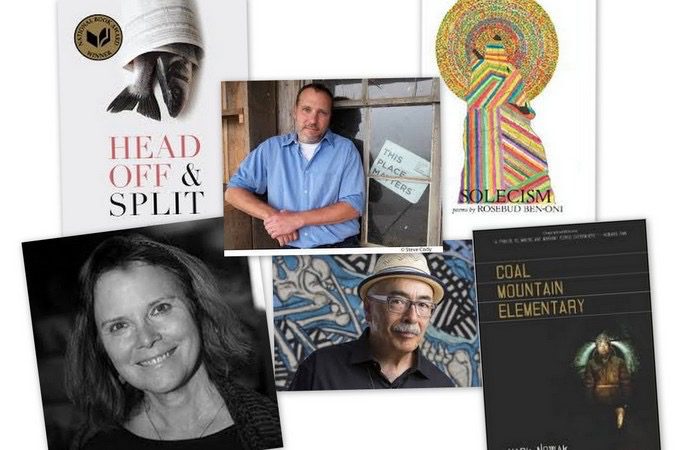I’m spending National Poetry Month at the Millay Colony, former home of Edna St. Vincent Millay. My colleague and friend, poet and writer Jen Fitzgerald, will be writing the Mixtape column this month—and we are all lucky for it. Enjoy Jen’s robust selections and I’ll see you in May.
Writing is born of living. I want nothing more than the poet to tell me what she has seen and can think of no better tribute to life than to render it into art. My own art seeks to create images that use subjectivity as a vehicle for illumination. Our voice, our point of view and the lens through which we see the world is important—it is how we connect, how we reach out to others. Our stories lie in the small spaces between what we have seen and what we say because the events that resonate with us are actually magnifying glasses. They allow us to see the fibers that make up the cloth of experience—it drapes us all.
- The Country Between Us by Carolyn Forche
This collection is my constant, it allows me entry through a multitude of passageways and I return to it over and over. Forche coined the term “poetry of witness,” and had to because she was writing in the tradition of poets like Miklos Radnoti, Paul Celan, and Czeslaw Miolsz—poets who had witnessed things so unfathomable that form and meter could barely contain it. But poetry proved to be the perfect container, as it knows and holds all things. When I first read “The Colonel” I said, thank heavens. Thank heavens we can write what we’ve seen, what we’ve witnessed and known to be true. Thank heavens we do not need to resist the impulse to be dragged to the page, to make beautiful the banal suffering of the human condition. And thank heavens I can discover what is important to me through the events, bodies, and voices that resonate. - Head Off & Split by Nikky Finney
I had the great opportunity to work with Nikky Finney during graduate school. She came to campus and read from this book as well as new work. I was finding myself, at the time, pulled to have truth in my poetry, to speak solely to truth and when I heard her read I wept. I openly wept in the auditorium, tried to hide it but couldn’t. During Q & A I asked her, “How do you give yourself permission to write about these things? How do you allow yourself to feel that pain in order to write it?” And she said, “Because it’s your damn job. It’s what you’ve been put here to do. You cry, sometimes a lot and then you write because these people’s stories need to be told. Do your job.” - The Common Man by Maurice Manning
I had kept poetry at arm’s length until I heard Maurice Manning read his work in 2006. This was the first time I felt that vortex of experience open up and suck me in; plus, I have the softest of spots for the colloquial prosody of Appalachia. Poets may not be storytellers but story telling is at the heart of what we do. Manning knows that what draws writers and readers to the page is the story—it assumes all forms and persists in all mediums. He speaks of a world that exists both then and now and renders them together beautifully, seamlessly, like how we imagine time might fit into its own landings and grooves.There are words and there are deeds, and both
are dying out, dying away
from where they were and what they meant.God save the man who has the heart
to think of anything more sad. - Solecism by Rosebud Ben-Oni
Part documentation of experience, part documentation of a time and place, Solecism speaks many languages with one tongue. It has a reverence for duality and a reverence for destruction as the first step toward creating a new thing. Ben-Oni breathes in meter and thinks on the plane just above where sound waves hit ears. The smallest of lines, stanzas, and poems hold the largest worlds.Night has become a kind of field dress.
A stranger stretching the iron
frame and we bend and bendinto a farther upon we cannot depend on.
- Notes on the Assemblage by Juan Felipe Herrera
This collection has not drawn a line; it is standing on a line already drawn. It stands on a border of language. It stands on a border of experience. It stands on a geographic border with a bullhorn. It wants to tell people on each side what it means to be on the other. It wants to direct the attention of each side, to the other. Because by the time we are laying the charred field together, face down, it will be too late to see each other for the first time. - Coal Mountain Elementary by Mark Nowak
Instead of the poet directly telling you what they have seen, Nowak pulls from three different sources to weave together a multi-layered narrative of what was seen, heard, felt, and understood. Mining is global, which means our experiences with collapse, fatigue, and black lung are closely linked. Nowak allows those with something at stake to speak for themselves. This form of elevation is rare in a poetry collection, it means ceding control of a speaker. Throughout the braided narrative is a grade school exercise for making “coal flowers.” The reader feels the presence of the next generation, the literal hands of the children being trained to handle their futures.
Support your favorite independent bookseller or shop:
***
Original logo art by Esme Blegvad.









